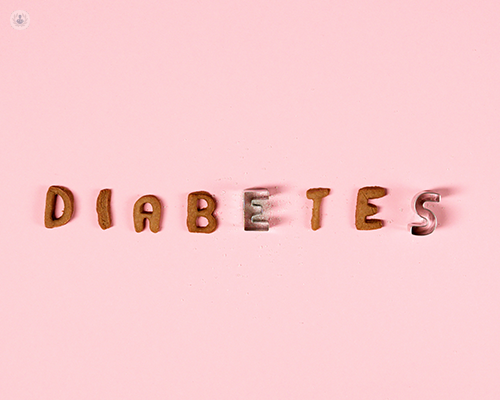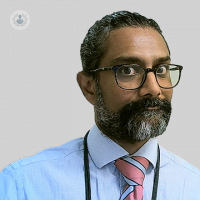The FreeStyle Libre flash glucose monitoring system: no longer a flash in the pan
Written in association with:If you are reading this article, you probably already have some idea what the FreeStyle Libre is and are seeking some insights into its use for diabetes, but there will be a few of you out there who are Libre naïve and inquisitive to know what all the fuss is about.

What is the FreeStyle Libre?
The FreeStyle Libre is a novel method of monitoring glucose that doesn’t involve the traditional pricking of fingers to obtain a blood sample.
For years I’ve helped patients enhance their diabetes management using the FreeStyle Libre. In this article, I’ll explain to you:
- How the Freestyle Libre works.
- How to read FreeStyle Libre data.
- The amazing benefits of the device.
- How you can get the Freestyle Libre on the NHS.
- The conditions of receiving it on the NHS.
- How I like to approach giving my patients the device.
But before we continue, take a quick look at what the FreeStyle Libre looks like.
How does the FreeStyle Libre work?
It uses a sensor that is easily inserted with an applicator. This applicator goes into the back of the upper arm and measures glucose levels in the interstitial fluid (the fluid that surrounds cells) in the subcutaneous tissues (the deepest layer of your skin). The glucose in the interstitial fluid is not simultaneously at exactly the same level as the blood glucose (which is the most accurate way of testing for glucose), but it does change in response to the blood glucose with about a 10 to 15-minute delay.
However, measurement of this interstitial fluid has been proven to reliably reflect glucose levels.1 Because of the 15-minute turnaround time of glucose values, it has been termed a “flash glucose monitor” rather than a “continuous glucose monitoring” (CGM) sensor.
How can I read FreeStyle Libre data?
The sensor requires a reader to access the glucose data but will also conveniently access the information via an app that can be downloaded onto a smartphone. The sensor monitors glucose every 15 minutes and as long as the sensor is scanned, it will retain the previous eight hours of readings. It will also retain information for 90 days, which handily is the timeframe that encompasses our traditional method of long-term glucose monitoring, the HbA1c. The Libre will also provide an HbA1c estimate itself. The FreeStyle Libre does not require any calibration; it takes about 60 minutes to warm up after insertion. Also, it’s water-resistant up to one metre. One sensor will last 14 days.
What are the benefits of using FreeStyle Libre?
The benefits of this system seem quite apparent
- There is easy access to glucose results every 15 minutes if required.
- The system conveniently shows the direction of travel of the glucose, together with the rate of travel, with a “trend arrow”.
- Patients can access the variability of their daily readings in a graphical form
- Data can be transmitted onto a Cloud-based system that allows invited healthcare providers access to that information remotely.
- The graphical form of the data demonstrates a time in the target range for the glucose. This variable is increasingly being used by specialists, alongside HbA1c as a marker of good control.
- The second generation of this sensor now even has an alarm for warning the wearer about impending hypoglycaemia.
Who can get the FreeStyle Libre on the NHS?
The FreeStyle Libre has been available to purchase in the UK since 2014. NICE (The National Institute for Health and Care Excellence) conducted an appraisal of it in 2017 and gave a positive response based on the 5 studies available at the time, together with input from 4 experts and Diabetes UK. In March 2019, NHS England set out plans for funding arrangements for relevant diabetes patients to receive a FreeStyle Libre on the NHS, rather than having to buy one independently.
This plan was centralised to ensure there was even access across the country to this technology. It was based on the assumption that 20 per cent of the Type 1 diabetes population would fit the criteria necessary for a prescription. The criteria included:
- Type 1 diabetes patients (or patients with any form of diabetes on haemodialysis) who require insulin therapy and/or intensive monitoring to improve their control, or patients with cystic fibrosis-related diabetes on insulin.
- Pregnant patients with type 1 diabetes for 12 months, including the post-delivery period.
- Patients with Type 1 diabetes who are unable to check their blood glucose due to disability, and require the support of carers to do so.
- Patients with Type 1 diabetes who have difficulty checking their blood glucose due to their occupation or for psychological reasons.
- Self-funders with Type 1 diabetes who have demonstrated improvement in their control with the FreeStyle Libre and fulfilled the criteria above.
- Patients with type 1 diabetes who have recurrent hypoglycaemia or hypoglycaemia unawareness.
What are the conditions for receiving a FreeStyle Libre?
There are a few requirements. Patient must:
- Have undergone education on flash glucose monitoring.
- Agree to scan more than eight times per day.
- Agree to reviews with their local clinical team.
- Agree to future attendance (or consideration of future attendance) to a Type 1 education course such as DAFNE (Dose Adjustment for Normal Eating).
Can FreeStyle Libre be prescribed long-term?
Whether a patient can receive a continued prescription of Freestyle Libre beyond six months would be dependent on the above criteria being met and on the improvement in the patient’s self-management of their diabetes e.g.
- HbA1c
- Time in range
- Frequency of attendances to hospital with diabetes-related problems
Has FreeStyle Libre been successful?
The distribution of the Freestyle Libre across the country has been a great success thanks to the diabetes tsars in England and the charity Diabetes UK leading the promotion of the technology, and with a great patient voice behind them, I hasten to add.
Early local and national audit data2 does suggest that its use is improving patient control, but what exactly is behind this? Is it that:
- The visualisation of the glucose is changing immediate behaviour?
- Patients are learning the impact of insulin and lifestyle on glucose values?
- Healthcare providers are adjusting insulin regimes with the sight of glucose trends?
Realistically, it is likely to be a combination of these factors.
How can patients switch to the FreeStyle Libre system?
The ability to access specialist help in diabetes when required can sometimes be problematical due to the staff shortages faced by the NHS. Having the dedicated time to go through the intricacies of the graphs is not always possible.
What I would like to provide is a 30-minute slot (for the price of a couple of sensors), to guide the client through the ups and downs of the glucose curve, with careful explanation and advice to enable the client to go forward with their own diabetes management, but with more tools in their bag to help them improve their control and time in range.
Dr Samarasinghe has spent many years assisting patients with diabetes. Visit his profile to learn how you can benefit from his professional and individualised patient care.
References:
1. Bailey T et al. The Performance and Usability of a Factory-Calibrated Flash Glucose Monitoring System. Diabetes Technol Ther. 2015;17(11):787-794.
6. Hoss, Udo., Budiman, Erwin. Factory-Calibrated Continuous Glucose Sensors: The Science Behind the Technology. Diabetes Technology & Therapeutics 19.S2 (2017): S-44
2. Deshmukh H et al. Effect of Flash Glucose Monitoring on Glycemic Control, Hypoglycemia, Diabetes-Related Distress, and Resource Utilization in the Association of British Clinical Diabetologists (ABCD) Nationwide Audit. Diabetes Care 2020;43:2153–2160


